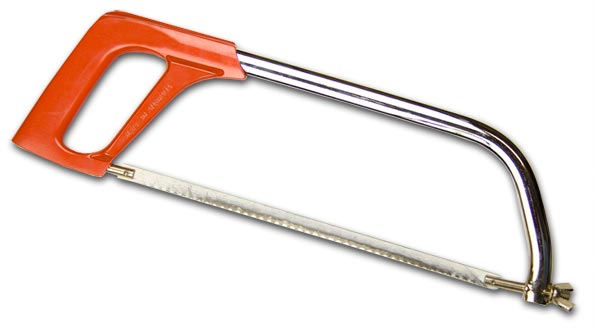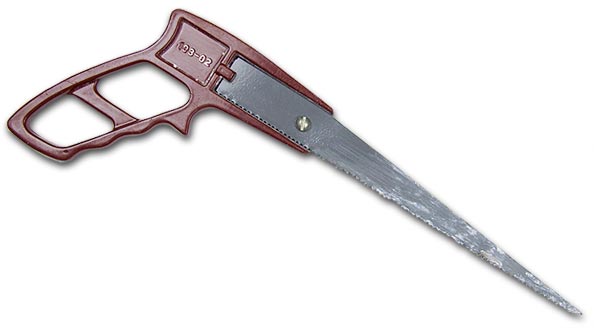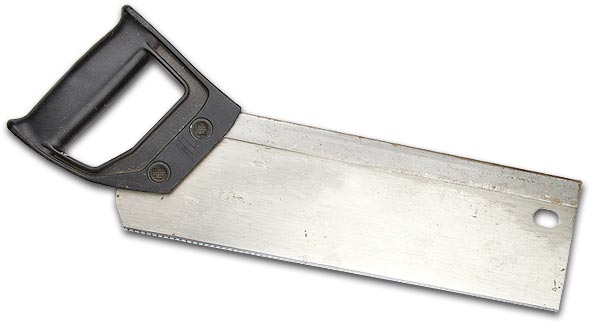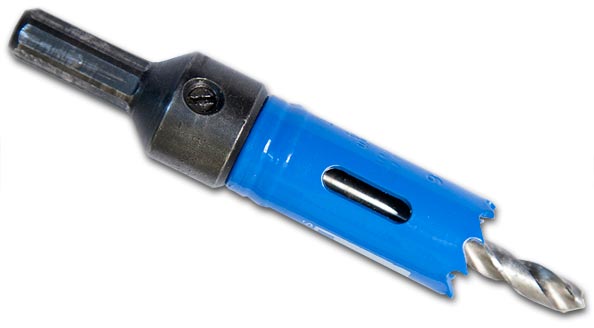Hand tools
Saws
There is a range of saws that are available for cutting various materials. The most common saws used in the electrical trade are hacksaw, crosscut saw, plaster saw and hole saw.
Hacksaw
The hacksaw can be used to cut a range of materials depending on the blade fitted. Most hacksaws have frames that are adjustable to take blade lengths of 250mm and 300mm. Blades are normally made from either a low tungsten steel `flexible’ or high speed steel (HSS) `all hard’.

Hacksaw
Hacksaw blades

Hacksaw blade
Flexible blades – have only the teeth hardened and are recommended for use where the work cannot be held firmly or is in an awkward position.
All hard blades – hardened throughout, use for sawing hard or tough metals. Their rigidity helps in accurate sawing and they will last longer than flexible blades. However, they will shatter if used incorrectly.
Teeth sizing and use
Blade teeth are usually specified by the number of teeth per inch/25mm (TPI). The blade pitches available are 14, 18, 24 and 32 TPI. Select a blade as follows:
- soft material – use coarse pitch to give ample chip clearance
- hard material – use fine pitch to give sufficient cutting points in contact with the work
- thin sections – use finest pitch to ensure a minimum of three teeth in contact with the work.
Rodsaw blade
Consists of a wire rod covered by tungsten carbide particles that can be mounted in a hacksaw frame. Being round, it will cut in any direction. The tungsten carbide allows the blade to cut ceramic tiles, hardened steel, glass, marble, fibreglass, brick, etc.
Plaster saw
A plaster saw consists of a pointed 150mm to 180mm tapered blade with rough pointed teeth and a handle.
Application:
- For plunge cuts in plasterboard. This saw is ideal for cutting openings for switches, socket outlets, exhaust fans, air conditioners, conduits and cables, etc.

Plaster saw
Cross-cut or hand saw:
The cross-cut saw is a versatile wood saw. A blade length of 550mm to 700mm and tooth size of six points per 25mm is recommended for general purpose applications.
Application:
- Ripping timber (cutting with the grain) of medium thickness.
- Cross-cutting the full range of structural timbers.
Common uses for an electrician include, cutting battens for clipping cable to, cutting out studs to mount air conditioners, and making noggins to support ceiling mounted light fittings.

Hand saw
Holesaw
The holesaw consists of a centre 6mm twist drill surrounded by a cylindrical blade. There are set size versions as well as versions with interchangeable blades for different diameter holes.
Application:
- Used with a suitable power drill to cut large diameter holes in a variety of materials, to facilitate cable or conduit entry, etc.

Hole saw



